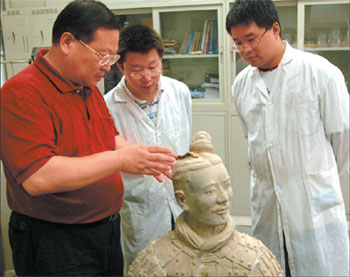Wu Yongqi, curator of the Qinshihuang Terracotta Warriors and Horses Museum in Xi'an, Northwest China's Shaanxi Province, is often called the "guard of the Qin terracotta warriors".
Since 1978, the 56-year-old has studied and protected these invaluable relics, part of which are now on show in the largest-ever overseas display of the Qin Dynasty (221-206 BC) artifacts at the British Museum.
Wu was among the large group of urban youths sent to the countryside for re-education during the "cultural revolution" (1966-76). The Beijing native worked as a farm hand for two years in Yan'an, Shaanxi Province. However, because of his myopia, he was denied jobs in the city three times.
Wu Yongqi (left) explains to his colleagues the structure of unearthed relics.
But fortune smiled upon the forlorn man in 1971, when the Shaanxi Provincial Museum opened its door to him and gave him a job as a guide.
"I think I was chosen simply because I can speak Mandarin without a local accent," Wu says with a smile.
With no formal education beyond middle school, Wu found the new job challenging. At first, he had difficulty explaining the history of relics displayed in the museum. But he worked and studied hard.
"Wu was a hardworking student in the museum, and he read a large number of ancient books and archaeological materials to learn more about the relics," says former director of the museum Yuan Zhongyi.
Seven years later, Wu was transferred to the newly constructed Qinshihuang Terracotta Warriors and Horses Museum and joined the team responsible for repairing the relics.
Since then, he has been whole-heartedly dedicated to the renovation.
Emperor Qin Shihuang (259-210 BC) established the Qin Dynasty, the first feudal empire in Chinese history. After his death, the emperor was buried in a mausoleum in Lintong District in eastern Xi'an.
In March of 1974, local farmers were drilling a well a kilometer and a half to the east of the tomb when they discovered the No 1 Pit.
The next year, the government drafted plans for the Qin Shihuang Terracotta Warriors and Horses Museum. The 16,300-square-meter pit was designed to cover the No 1 Pit.
Thousands of life-sized terracotta warriors and horses were unearthed from the site, and in 1976, two more excavation sites - No 2 and No 3 pits - were uncovered. The discovery soon became recognized internationally as the Eighth Wonder of the World.
The museum officially opened in October 1979 and has since attracted millions of visitors both home and abroad annually.
Wu Yongqi stands face to face with his life-long friends - terracotta warriors.
It was Wu who led the team of Chinese and German scientists to discover how to preserve the color painted on the surface of the warriors.
The astonishing sculptures lost much of their coloration during the two millennia they spent underground. And the remaining, faint coloration began fading immediately after excavation because of the sudden change in temperature and humidity.
It wasn't until the 1990s that Wu's team made a breakthrough, developing a special lotion that binds the pigments to the terracotta.
Thanks to their efforts, visitors can today view the warriors and have a better idea of how magnificent they appeared when they were first completed.
In acknowledgement of the technology Wu's team developed, the State Administration of Cultural Heritage established a national protection center for ceramic relics in the museum.
In the 1980s, Wu also participated in the excavation and preservation of the delicate terracotta sculpture of horses pulling a chariot. "It took us about 10 months to put together the horses and chariot, which was broken into thousands of shards upon excavation," he recalls. "The whole process was riddled with excitement and difficulties."
Wu couldn't count the number of political leaders and guests he's received over the decades he had been the head of the museum. His colleagues often affectionately call him "No 1 Tour Guide".
He remembers that Bill Clinton once joked that he also wanted to be the curator during his visit at the museum.
But Wu was most impressed by an ordinary guest in the 1990s, who carried his wife's cinerary casket through the museum. The staff was deeply moved when the man said he came there to fulfill his wife's final wish.
Wu seldom watches TV or movies, but he has seen Jacky Chan's The Legend several times.
This, he says, is not because part of the film was shot at the museum, but rather, because of the scene in which the hero returns the relics he has unearthed to the museum.
"The Mausoleum of Emperor Qinshihuang is a fabulous underground kingdom. And the terracotta sculptures are only a part of its immense treasure trove. Every time I see this huge, marvelous army of warriors and horses, I feel their powerful force," he says.
Wu was recently elected as a deputy to the 17th National Congress of the Communist Party of China, which will commence in October.
(China Daily September 26, 2007)



